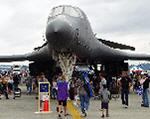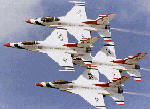
|
Description
| Notes: Upgraded F-14A. | ||
| Manufacturer: | Grumman | |
| Base model: | F-14 | |
| Designation: | F-14 | |
| Version: | B | |
| Nickname: | Tomcat | |
| Designation System: | U.S. Tri-Service | |
| Designation Period: | 1962-Present | |
| Basic role: | Fighter | |
| Crew: | Pilot & RIO | |
| First Flew: | 1973/09/12 | |
Specifications
| Length: | 62' 8" | 19.1 m | |
| Height: | 16' 0" | 4.8 m | |
| Wingspan: | 64' 1" | 19.5 m | |
| Wingarea: | 565.0 sq ft | 52.4 sq m | |
Propulsion
| No. of Engines: | 2 | ||
| Powerplant: | Pratt & Whitney YP401-P-400 (A/B 28,000Lb) | ||
Performance
Operators (Past and Present)
| USN | VF-24 | Miramar | CA |
| USN | VF-74 | Oceana | VA |
| USN | VF-101 | Oceana | VA |
| USN | VF-103 | Oceana | VA |
| USN | VF-142 | Oceana | VA |
| USN | VF-143 | Oceana | VA |
| USN | VF-211 | Miramar | CA |
| USN | VX-4 | Point Mugu | CA |
Known serial numbers
Examples of this type may be found at
| Museum | City | State |
| Intrepid Sea-Air-Space Museum | New York | New York |
F-14B on display
Intrepid Sea-Air-Space Museum |
Recent comments by our visitors
| ryan wilmington, NC | hey i was with vf-103 95-98 it was sad to see the tomcats go. many fine memories with the tomcat and vf-103. i have lost my cruise video from the 96 med cruise. if anyone has one please email me thanks 12/12/2006 @ 12:14 [ref: 14981] |
| Chuck143 Hambden Twp, OH | I served in VF-143 at NAS Oceana at the perfect time. We transitioned from the F14A to the F-14A+. The difference between these to jets were the engines and some slight modifications to the airframe. Basically we went from the TF30-P414A to GE-F110 power plants and the glove vanes on the leading edges were eliminated. We then transitioned into the F-14B shortly there after, the big mystery here is that we started to drop bombs. The F-14D was the avionics that was upgraded. Also, the F-14D was the only F-14 to have the dual TCS cameras mounted on the bottom of the radome. The picture identified as an F-14B is either an F-14D, or it could be a F-14B and they placed a dual camera system on the jet for visual static purposes.
Great picture of the last flight of the "PUKIN DOGS" I guess this is not a politically correct term these days. 03/17/2006 @ 11:19 [ref: 12834] |
| Frank Daloisio Canton, OH | The Military Aviation Preservation Society (MAPS) Air Museum located at the Akron-Canton Regional Airport now has an F-14B Tomcat in its collection. The Tomcat arrived at the airport during the first week of October 2005 and performed about four or five passes over the museum before landing for its last time.
It served aboard the USS Harry S. Truman and the number on the wing is 115. As I get more information, I will pass it on to all visitors at this site. 10/17/2005 @ 09:09 [ref: 11493] |
| George A. Cepeda , OH | Actually, the entry on the F-14B pictured (the prototype "Super Tomcat," BuAer 157986) has a mistake. The plane actually flew with three types of engines. Originally, it flew with a TF30 in one side and an F401 in the other side, then with two F401s.
The plane had a very short flight program in late 1973 and was put into storage for 8 years. It was brought out of storage, dusted off and slightly repainted, then modified with GE F101DFE (derivative fighter) engines -- the prototype engines developed into the F110-GE-400 engines that power today's F-14Bs and F-14Ds. After another short flight program in 1981 that validated the effectiveness of the F110, the "Super Tomcat" was again put into storage for another 5 years. The aircraft was reactivated and modified to fly with production-standard F110 engines as part of the F-14D development program. A couple of interesting points about this prototype -- as far as I've read, it NEVER flew with a production radar set! Secondly, it tested a mockup of the dual IRST/TV camera chin pod that's standard on the F-14D. Lastly, it also earned a small footnote by validating supercruise capability of the F-14B/D by being the first US fighter to supercruise in over a decade. (The YF-17 achieved supercruise in the 1970s.) It demonstrated that F-14s powered by F110s could supercruise over a year before the first test flights of the ATF prototypes. 03/20/2005 @ 08:27 [ref: 9755] |
| Steve & Corine Galeener Bellflower, CA | Sad Day:
Grumman F-14B 162921 from the VF-143 "Pukin' Dogs" based at NAS Oceana, VA. The aircraft is seen just pulling up on the AMARC arrivals ramp on December 22, 2004 after it's delivery flight from Oceana. Originally designed and procured as an air superiority and fleet air defense fighter aircraft, the mighty Grumman F-14 Tomcat has, over the more recent years, been used with extreme effectiveness as an air-to-ground strike aircraft. Capable of carrying a wide range of General Purpose and Laser Guided Bombs (LGB's) and Joint Direct Attack Munitions (JDAM), the F-14 also has the LANTIRN (Low Altitude Navigation and Targeting Infrared for Night) targeting system which allows the delivery of laser-guided bombs during precision, air-to-ground strikes. The F-14 Tomcat has served with distinction in all of the major conflicts of recent years, including Desert Storm (1991), Southern Watch (1991-2003), Deliberate Force (1994), Allied Force (1999), Enduring Freedom (2001) and Iraqi Freedom (2003). The F-14 is an expensive type to operate, in fact it is the most expensive aircraft to operate in the US Navy inventory. It is a large aircraft which has impressive performance and the ability to carry a formidable quantity of ordinance, including the legendary Phoenix missile system. However, the world has changed since the F-14's introduction to service back in 1972, the times when they were required to intercept Soviet fighters and bombers during the Cold War are long gone. The F-14 has adapted well to it's newly acquired roles but the years of operating above the salt water and slamming onto carrier decks have also taken their toll. During Operation Iraqi Freedom the F-14 served alongside it's selected replacement, the F/A-18E/F Super Hornet. The Super Hornet is acknowledged as not only being a more capable fighter and ground attack aircraft than the F-14 but can also provide an in-flight refuelling capability. It is not a 'perfect' aircraft and will undergo upgrades and refinements which other aircraft have had to go through, but the type performed admirably in this it's first combat operations. The fact that the F-14 can hold it's own against most other combat aircraft, including the F/A-18 E/F Super Hornet, is just not good enough in this time of shrinking budgets and cost justification. As a result the F-14 Tomcat is now in it's last year or two of service. Examples of the type will be arriving at AMARC on a regular basis until the remaining F-14 squadrons transition to the F/A-18 Hornet or are disbanded. It is planned that the remaining F-14B's and F-14D's will remain in service until 2006, operating with the following squadrons : VF-11 Red Rippers F-14B May 2005 VF-31 Tomcatters F-14D September 2006 VF-32 Swordsmen F-14B November 2005 VF-101 Grim Reapers F-14B/F-14D Disbanding in September 2005 VF-103 Jolly Rogers F-14B March 2005 VF-143 Pukin' Dogs F-14B April 2005 VF-213 Black Lions F-14D May 2006 An aircraft type that was initially disliked by the pilots who flew them, the F-14 Tomcat has overcome quite a number of major flaws and has earned the respect from all those who have served with them. They will miss the Tomcat's high-speed, endurance and long range capabilities, as well as the ability to find and engage aerial targets at much longer ranges than other current fighter types. Brief History The Grumman F-14 Tomcat project was initiated in 1968 in response to the US Navy's proposal for the VFX (Navy Fighter Experimental). The VFX would challenge Grumman's aircraft designers with a long list of requirements including; two engines, two seats in tandem configuration, powerful radar, advanced weapons, systems, internal gun, the ability to carry a wide variety of short, medium and long range missiles and the ability to land on an aircraft carrier fully loaded. The requirements were so demanding that the US Navy levied a comprehensive set of financial penalties which Grumman would have to pay if their guarantees were not met. The first F-14 flight took place on December 21, 1970 from Calverton, New York. This program did not get off to a good start with the loss of the first prototype on December 30, 1970 due to hydraulics failure, fortunately without loss of life. In total, fourteen F-14's were used during the test and proving programs. On October 8th, 1972, the Fleet Replacement Squadron, VF-124, received their first F-14A. The first operational squadrons to receive the F-14, VF-1 and VF-2, started to receive their aircraft during July 1973. The first deployment started in September 1974. By the time the production line closed Grumman had produced a total of 710 F-14's, the last being delivered to the US Navy on 20 July 1992. AMARC, or the Aerospace Maintenance And Regeneration Center, is a joint service facility managed by the US Air Force Material Command located in the town of Tucson, Arizona, USA. Often referred to as 'The Boneyard', AMARC is an aerospace storage and maintenance facility adjoining Davis-Monthan Air Force Base which provides a service to all branches of the US military (Air Force, Navy, Marines and Army), as well as the Coast Guard and other national agencies. 02/27/2005 @ 08:52 [ref: 9546] |
| F-14A AQshop , PA | when they up'd the engs on the alfa.
the scuttlebutt was the eng"s tookoff but the bird stayed tyed down. this true? or did it fly? also vf-24 flew alfas then deltas 10/23/2004 @ 08:51 [ref: 8494] |
| James Hall , WV | Any Jollyrogers(103) from the 96' Med cruise give me a shout. P.S. Check out the "CHARIOT OF DOOM" flying over the oil fields and in the burner shot. That used to be my plane as a young airman plane captain. It's great to see it again. GOD BLESS the Tomcat community and the Fags too since they now have one of the finest ADSC's in the Navy. 09/01/2002 @ 23:45 [ref: 5602] |
| Jeffrey Stone Richmond, VA | The first eight photos below of the VF-102 homecoming and VF-11/143 flyby's are actually mine and do not belong to the credited poster, Steve & Cori Galeener of Bellflower California . While I'm happy that others enjoy my images and like to share them I still do believe in keeping my images as my own. Please see my naval aviation site for more:
http://art-thing.com/jsnas Thanks. 06/03/2002 @ 11:23 [ref: 5042] |
| CAG , PA | Actually, the F-14 is a formidable dogfighter from what guys that graduated from Top Gun at NAS Fallon.. as it's a turn radius fighter not a turn rate fighter as the 15C or 16. The F/A18 is also a turn radius fighter.
03/13/2002 @ 00:32 [ref: 4497] |
| Christian Blachford , MI | This F-14B is the prototype F-14B, with P&W powerplants. Not the GE-110 service F-14A+ (F-14B). 10/19/2001 @ 23:11 [ref: 3437] |
Recent photos uploaded by our visitors





